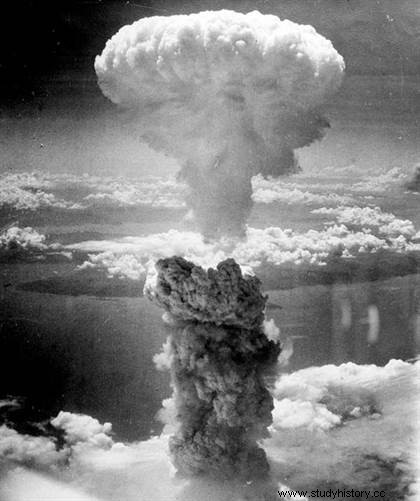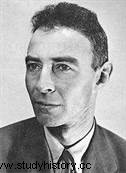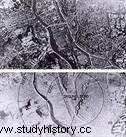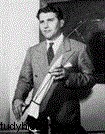 Theatomic bomb (A-bomb) is probably one of the most diabolical inventions in history. Its development was made possible thanks to the progress made on the nature of the atom at the beginning of the 20th century. For the first time in the hands of the United States , in 1945 , it ended the Second World War in the most spectacular human drama in history. Even today, the images of fungi from the two A-bombs developed by the team of American scientists led by J. Robert Oppenheimer are the terrifying symbol of planetary holocaust at the push of a button.
Theatomic bomb (A-bomb) is probably one of the most diabolical inventions in history. Its development was made possible thanks to the progress made on the nature of the atom at the beginning of the 20th century. For the first time in the hands of the United States , in 1945 , it ended the Second World War in the most spectacular human drama in history. Even today, the images of fungi from the two A-bombs developed by the team of American scientists led by J. Robert Oppenheimer are the terrifying symbol of planetary holocaust at the push of a button.
Atom and nuclear fission
In 1907, Ernest Rutherford was the first to conclude from his research that the atom is mostly empty but has a very dense and very small nucleus, filled with particles. In 1919, he carried out the first atomic transformation of nitrogen into oxygen. This is the first nuclear reaction.
In 1939, two German scientists, Otto Hahn and Fritz Strassmann, discovered that they could burst the nucleus of a uranium atom into much smaller fragments. The reaction is accompanied by the release of a large amount of energy:this is nuclear fission. The small fragments resulting from fission can themselves cause other nuclei to burst:this creates a chain reaction. This phenomenon is experienced in France by the physicist Frédéric Joliot .
These different discoveries allow scientists to glimpse the possibility of using the considerable energy of atoms to transform them into weapons based on fissile elements such as uranium 235 or plutonium-239 . But at the dawn of the outbreak of the Second World War, there was still a long way to go before this idea could be made a reality.
Robert Oppenheimer, inventor of the atomic bomb
We had to wait until August 2, 1939 and a letter from Albert Einstein to President Roosevelt for such a project to take on its full scope in the United States. Einstein alerts the American president to the advanced work of the Nazis in the field of nuclear armament, which causes a consequent increase in the funds allocated to research.

These efforts lead, in the greatest secrecy, to the launch of the Manhattan project edited by physicist Robert Oppenheimer and GeneralLeslie Grove s, in 1942. A number of eminent European and American scientists, including physicists Enrico Fermi , Richard Feynman , Edward Teller , the mathematician John von Neumann and the chemist Harold Urey , were associated with this project, which ended up employing more than 130,000 people in 1945. Quite simply, the largest scientific project ever carried out worldwide.
 The result of considerable scientific and industrial efforts carried out across the United States, a first plutonium bomb (called " Gadget "), was tested on July 16, 1945 in the desert of New Mexico . This first atomic bomb (A-bomb) was a plutonium device with a power of 22 kt. While explosives used before this date derived their power from the rapid combustion or decomposition of a chemical product, nuclear explosives use the transformation of atomic nuclei as their energy source.
The result of considerable scientific and industrial efforts carried out across the United States, a first plutonium bomb (called " Gadget "), was tested on July 16, 1945 in the desert of New Mexico . This first atomic bomb (A-bomb) was a plutonium device with a power of 22 kt. While explosives used before this date derived their power from the rapid combustion or decomposition of a chemical product, nuclear explosives use the transformation of atomic nuclei as their energy source.
Hiroshima and Nagasaki:prelude to nuclear holocaust?
Building on the success of the operation, two more bombs, one with uranium (Little Boy ) and the other plutonium (Fat Man ), are dropped on Japanese cities from Hiroshima August 6, 1945 and Nagasaki August 9. They force the Emperor of Japan to capitulate and thus put an end to the series of wars he had started since 1931.
In Hiroshima, the bomb dropped by the American bomber Enola Gay instantly kills 75,000 people, for a total of around 250,000 in the following weeks and months. The city is totally razed. A dramatic human toll, immortalized by the film Hiroshima mon Amour . A final escalation in the bloodbath of the Second World War, and the disastrous demonstration that man is in the process of inventing the most effective means of destroying his own species.
Nazis gave up nuclear weapons

For their part, the Nazis preferred to focus their research on other advanced weapons, first and foremost the V1 rockets then V2 , but also prototypes of flying saucers , the first jet planes such as the He 178 then the Messerschmitt Me262 Schwalbe, or the first stealth submarine U-480. Yet at the forefront of technology since the 1930s, the Germans never really believed in the power of domination of this weapon. And even if Hitler had he decided to devote considerable resources to it, it is likely that the United States would still have succeeded in designing the bomb first.
However, the possibility of a nuke in the hands of the Nazis is blood-curdling. London and Moscow probably razed from the map, "inferior populations" quickly eliminated, the fate of Europe but also of the world would probably have fallen into the most sinister barbarism, as imagined, for example, by Philip K. Dick in his fictional novel "The Master of the High Castle".
Invention of the "H" Hydrogen Bomb
After the Second World War and the Cold War set in, most of the great powers sought to equip themselves. Thus, on August 29, 1949, the Soviets exploded their own plutonium A-bomb. The United States no longer has a monopoly on nuclear weapons and is embarking on a new race, that of the nuclear fusion bomb. Harry Truman is the instigator of this new challenge, but he immediately comes up against the refusal of Oppenheimer . The latter, like most of his scientific counterparts in the forefront of which Einstein, is indeed horrified by the consequences of the A-bomb and does not want to be held responsible for a genocide.
The first H-bomb will still see the light of day, on November 1, 1952 under the sweet name of 'Ivy Mike , off Bikini Atol. A thousand times more powerful than the first A-bombs, its destructive capacity far exceeds the estimates of scientists led by Edward Teller . The H-bomb will later make it possible to design weapons with greatly reduced dimensions allowing the development of nuclear shells for artillery and small missiles that can be fired by portable launchers.
Nuclear bombs are the most destructive devices in existence. Current models have powers 8 to 40 times greater than those of the Little Boy and Fat Man bombs, which devastated Hiroshima and Nagasaki in 1945.
Spread of atomic weapons and nuclear deterrence
Becoming the absolute weapon, the atomic bomb attracts the covetousness of most of the great powers. Thus, the British manage, on their own, to design their first "viable" bomb in 1957. The People's Republic of China (1967) and France (1968) followed the same path, building multi-megaton "H" bombs. India , Pakistan , Israel , North Korea and probably also Iran are the latest members to join the sinister club of nuclear powers.
Nuclear bombs, fortunately never used in a war after 1945 (but probably tested on civilians and soldiers), quickly became instruments with multiple applications strategic and tactical. They can be dropped by aircraft, rockets and missiles, from the air, the ground and even submerged submarines. The possession of large quantities of nuclear weapons ensures "mutually assured destruction" in the event of the engagement of nuclear armament. This is the doctrine of balance of terror, which each side strives to uphold.
 Virtually impossible to intercept, capable of annihilating any capital of any large city at any time nation, the atomic bomb has become the weapon of deterrence par excellence. A strange paradox for this abominable invention, the proliferation of which has probably made it possible to avoid many major conflicts, but which could at any time cause the human species to disappear from the face of the earth...
Virtually impossible to intercept, capable of annihilating any capital of any large city at any time nation, the atomic bomb has become the weapon of deterrence par excellence. A strange paradox for this abominable invention, the proliferation of which has probably made it possible to avoid many major conflicts, but which could at any time cause the human species to disappear from the face of the earth...
To go further
- The Atomic Bomb:The Strategy of Terror by Samy Cohen. Galimmard, 1995.
- Why Hiroshima? :The decision to use the atomic bomb by Barthélémy Courmont. The Harmattan, 2007.
- The Heisenberg Mystery:Nazi Germany and the Atomic Bomb, by Thomas Powers. Albin michel, 1993.
